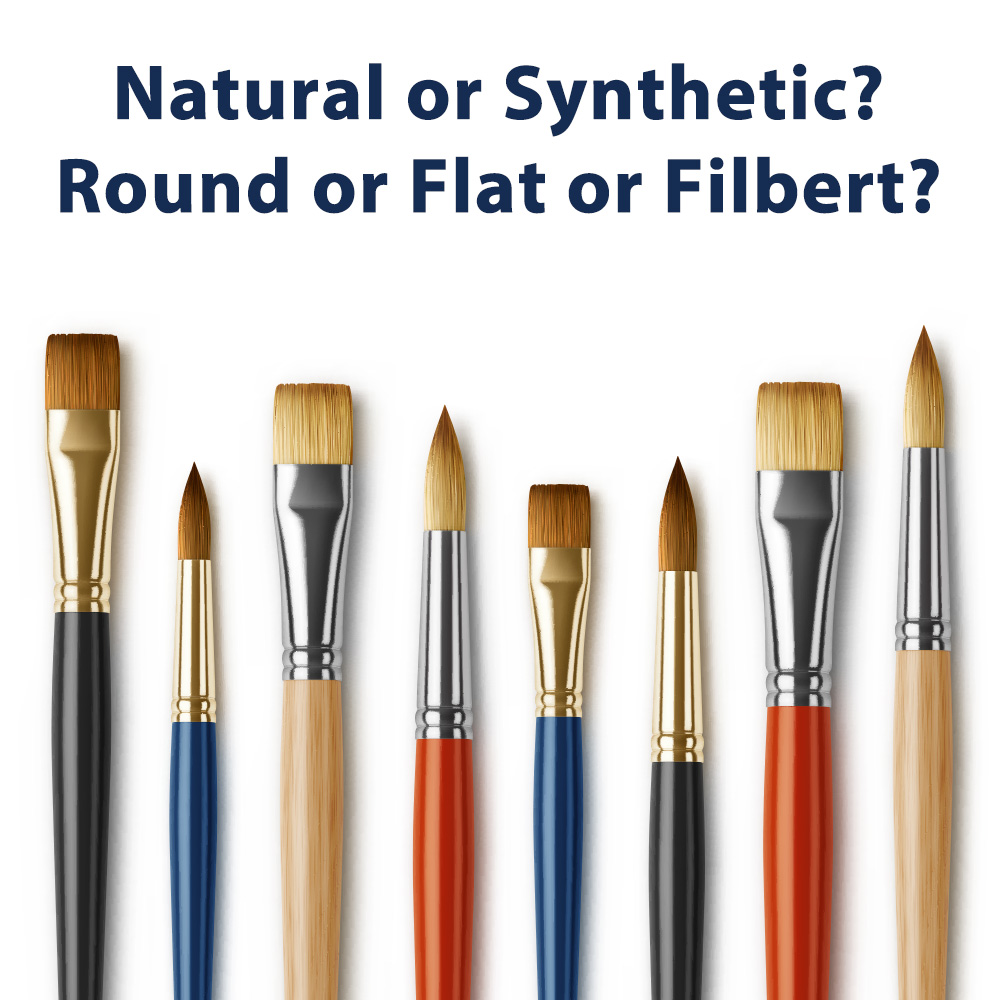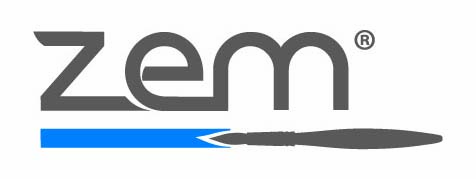Artists' paintbrushes are a fantastic resource for expression, but choosing the best one can be daunting considering the wide variety on the market. With the right brush, you're closer to getting professional results when using acrylic, oil, or watercolor paints. Have no fear! Zem Brushes has prepared this ultimate artist's paintbrush buying guide to help you select the ideal brush for your project. Read on!

This guide is ideal for beginner painters seeking the fundamental brushes they need to get started and pros who wish to expand their brush collection. Should you use natural or synthetic bristles? A round or a flat shape for that effect? Is it better to go for the most expensive? We explore the choices to learn how to choose the right paintbrush for your artwork, including size, shapes, and bristles.
- Kolinsky Sable
- Ox Hair
- Raccoon Hair
- Russian Sable
- Soft Fluffy White Hair.
- Synthetic bristles
- Angular brushes - Flat with a sloping border. Ideal for shading, highlighting, and filling in tight areas and corners.
- Bright brushes - Flat with inwardly curved edges at the tip. Ideal for mixing, heavy colour application, and controlled strokes.
- Cat's Tongue brushes - The cat's tongue brush, so named for its flat but rounded shape, is a specialized brush used for painting broad strokes and softening sharp corners. Great for painting landscapes or the ocean!
- Deerfoot brushes - The surface is flat with inwardly curled edges at the tip. Ideal for blending, strong application of colour, and precise strokes.
- Fan brushes - Like flat and dispersed as a fan. Ideal for mixing, feathering, and producing textural effects.
- Filbert brushes - The edge is flat and rounded, giving an oval shape. Ideal for blending, color washes, highlighting, and shadowing.
- Flat brushes - Bristles of medium length with a square tip. Ideal for broad, bold strokes, covering large areas, washes, borders, delicate lines, and stripes.
- Long Liner brushes - They can be used with acrylic, watercolor, poster color, gouache, and tempera paints. With a short handle for stability and precision, this brush is ideal for delicate lettering, highlighting, and long, unbroken strokes due to its fine and thin design.
- Medium Liner brushes - The medium liner brush has a fine, denser tip with medium-length bristles that are ideal for the most precise application. Use it to create graphic liner looks, elaborate face and body art, or an accurate wing liner.
- Mop brushes – Super soft, high-quality goat hairbrush. Ideal for mixing, blurring, softening, and creating expansive washes.
- Mottler brushes - Mottlers are ideal for priming surfaces due to their pigment-holding capacity. Mottlers are handy for varnishing large areas and underpainting color blocking.
- Round brushes - These traditional brushes have either a rounded or pointed tip—ideal for area filling, outlining, drawing, intricate work, and controlled washes.
- Stencil brushes - A round brush with firmly packed bristles. They are specifically designed for stenciling.
- Wash brushes - A brush that resembles a flat brush but has a squarer and larger head. Ideal for filling up huge areas and creating color washes.
- Natural-haired oil paintbrushes
- Synthetic-haired oil paintbrushes
How to buy paintbrushes
Your paintbrush should feel like an extension of your arm. They are the tools that allow artists to create their vision and bring their work to life. With the right paintbrushes, an artist can create stunning pieces that amaze and inspire.
However, with the wrong paintbrushes, an artist's work can suffer. Poor-quality paintbrushes can make it difficult to achieve the desired results and could even damage the painting. This is why it is so important for artists to choose their paintbrushes carefully and to invest in high-quality brushes that will serve them well.
Important characteristics of a quality paintbrushes
Brush bristle/hair
Bristles used in paintbrushes can be either natural or synthetic and vary in absorbency, stiffness, and springiness (how quickly they return to their original shape). When painting with paints that spread easily, like watercolor, softer brushes are better because they make smoother brushstrokes. Tackier paints, like oils and acrylics, require stiffer brushes because of the textured effects they produce.
Natural hair or bristles
When it comes to oil paint brushes, natural bristle brushes are better. They are considerably softer and will react better to the oils in the paints. Bristles made from natural hair are of superior quality and have a longer lifespan.
Natural brushes employ the following animal hairs:
You can find synthetic brushes with bristles made of nylon or nylon/polyester mixes. A nylon/polyester blend strikes a nice balance between being soft enough to leave a smooth finish and being stiff enough to give you adequate control.
You can also use synthetic brushes for oil painting, but be aware that the paint thinners used for oil painting will be more damaging to brushes.
Pro's Hint:
It's crucial to evaluate the quality of either kind of brush before making a purchase. Holding the bristles between your thumb and index finger, you shouldn't feel any bristles come out when you gently tug. You should get a better-quality brush if you notice that it loses a lot of bristles. You should invest in long-lasting brushes to prevent hairs from breaking off and spoiling your artwork.
Brush shape
Different types of paintbrushes serve specific functions. Below is a list of artists' most popular brush types today.
Brush size
The size of a paintbrush is displayed on the handle and refers to its length or width. The larger the brush, the greater the number. Since there is no industry standard for brush sizes, it is advisable to familiarize yourself with a single brand.
The most common sizes are from 000 to 20. Alternatively, sizes may be labeled as 4/0, 10/0, 12/0, and others. These indicate the number of zeros, so 2/0 is 00, 4/0 is 0000, etc. The brush size decreases as the number of zeros increases.
Sometimes, flat brushes are labelled by their width in inches, so you may encounter sizes such as 1/2", 3/4", 1/8", and more.
Does the brush size matter?
It is essential to have small, medium, and large brushes. Particularly, you should stock up on medium and large brushes, as these should accomplish most of the work in your paintings, but you'll need smaller brushes for detailed work.
When choosing a paintbrush, consider the type of paint you'll be using, the surface you're painting, and the effect you're trying to achieve. For example, if you're painting a large mural, you'll need a different brush than if you're painting a small model car. Also, if you're using thick paint, you'll need a different brush than if you're using thin paint.
Paint type
Acrylic
Brushes made of synthetic materials, rather than natural ones, are recommended for working with acrylic paints since they are more durable and can withstand the medium better. We suggest those made of hog bristles or a similarly firm synthetic material.
Most brushes we recommend for acrylic paint are synthetic; some are designed to feel like natural hair but are much firmer.
Oil
Traditional oil painting brushes are long-handled, allowing the artist to compose from a distance. However, short-handled and medium-handled varieties are also available, ensuring the perfect fit for every effect!
The material from which the bristles are produced is the determining factor in this choice:
Hogs hair paint brushes are durable and hold more paint. They are great for thick applications and wider brush strokes. Hog bristles (sourced from pigs) are ideal for oil paintings due to their strength, resilience, and ability to enhance the characteristics of the paint.
Sable brushes , another type of natural-bristle oil brush, are typically constructed from the tail hair of weasels. If your painting needs thin lines and shapes that would be hard to make with a bigger brush, these are the best brushes to use. The bristles are fine and sharp, making it easier to control the details.
Neither vegans nor people very fond of animals tend to gravitate towards brushes made from natural materials. If this is an issue, consider purchasing synthetic hair oil paintbrushes. Natural bristles may be softer, but synthetic ones are much more durable and can take a beating in the paint or on the road.
If you are on a tight budget and require oil paint brushes, synthetic ones can again be your best option. Synthetic oil paintbrushes of superior quality from a reputable manufacturer will enable you to meet your artistic needs without spending a small amount on natural bristles.
Watercolor
For watercolors, it's best to use natural brushes like sable or squirrel hair brushes because they retain their shape better and can handle more water. Sable hairs are used in the manufacturing of many watercolor brushes because they are long, smooth, and typically harvested from the tail. The highest quality is called Kolinsky sable.
Some additional frequent hair kinds include squirrel (used for huge mop brushes) and goat (and sometimes ox) for more affordable natural hairs.
Synthetic hair works just as well, but natural hair may hold significantly more paint. The reason for this is that their fibrous structures are exceptionally good at absorbing and storing water. In addition, because of their heightened responsiveness to pressure, they often feel like natural extensions of the artist's hand.
Costs
Buying high-quality brushes for your job is always recommended. Poor brushes may fail. Poor-quality hog hair artist brushes splay and soften, leaving untidy lines and affecting color control. Cheap, soft synthetic brushes may lose their sharpness and hold little color. Poor-quality brushes degrade quickly, so you may spend more on two or three inexpensive brushes than on one high-quality brush that lasts for years.
Which brand of artistic paintbrush should I use?
We recognize that different effects require different tools and that it might be challenging to determine which ones to use. Choosing the most effective paintbrushes is not always simple. We hope our guidance on buying artists' paintbrushes helps you select the ideal paintbrushes for your next artwork project.
Remember, it takes time to become comfortable with the various shapes, sizes, and bristles. Practice leads to mastery. Follow our hints, and you'll soon be a brush expert.
How to buy paintbrushes in Zem Brushes
With over 40 years of history in the brush market, Zem Brushes is one of the largest art brush suppliers in the United States, with a vast inventory and prompt, courteous service. We know brushes are a vital instrument for artists.
We endeavor to offer our high-quality brushes manufactured in the USA, Germany, and India at competitive prices that are ideal for artists, resellers, schools, and online sellers. Our website is safe, and personal information is kept private. We are a family-owned company that employs a staff of highly competent brush makers. We believe that our enthusiasm for our art is evident in our products.
And take good care of your brushes, and they will last a long time.

Read also:
Thanks for reading! Feel free to share with your friends. Check our blog section if you're looking for additional painting advice! Or contact us!

